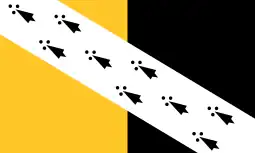 | |
| Proportion | 3:5 |
|---|---|
| Adopted | 11 September 2014 |
| Design | A vertical bi-colour of gold and black, with a white bend dexter bearing nine alternating black ermine spots between pairs and singles. |
| Designed by | Traditional |
The flag of the English county of Norfolk consists of a vertical bi-colour of gold and black, with a white bend bearing nine black ermine spots alternating between pairs and singles. It was officially registered on 11 September 2014 as a traditional county flag, following a campaign by Norfolk resident Dominic Victor Maverick Smith.[1]
Design and symbolism
The flag's design is the banner of arms attributed to the first Earl of Norfolk, Ralph de Gael. This 12th-century design has been associated with the county ever since, appearing on maps and books and forming the basis of the county council arms awarded in 1904. It is thought that the ermine bend (the diagonal stripe from top left to bottom right) found in the design may be a reference to Brittany, where Ralph was Lord of Gaël; the dukes of Brittany bore a shield of plain ermine, and accordingly ermine figures in much Breton heraldry, including the regional flag. This ermine pattern has had differing designs but for the registration a precise form was chosen in consultation with the Flag Institute and a flag bearing this design was commissioned by the Association of British Counties. This pattern was duly registered.[2][3]
| Scheme | Yellow | Black | White |
|---|---|---|---|
| Pantone[4] | 123C | Black | White |
| RGB | 255-199-44 | 0-0-0 | 255-255-255 |
| Web colors | #ffc72c | #000000 | #FFFFFF |
| CMYK | 0-22-83-0 | 0-0-0-100 | 0-0-0-0 |
References
- ↑ vexilo (19 September 2014). "Norfolk Flag". British County Flags. Retrieved 14 February 2019.
- ↑ "Norfolk Flag - British County Flags". 19 September 2014.
- ↑ The Flag Institute.
- ↑ "Norfolk". The Flag Institute. Retrieved 14 February 2019.